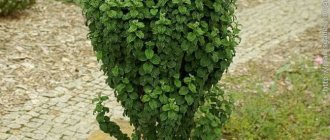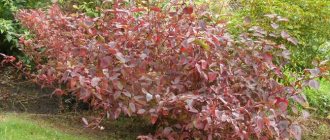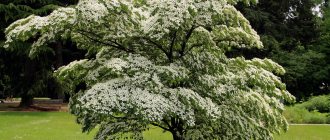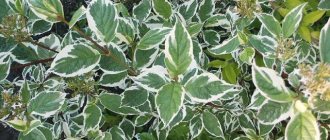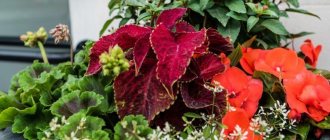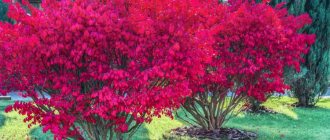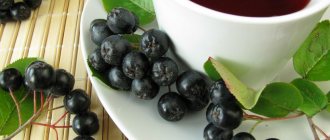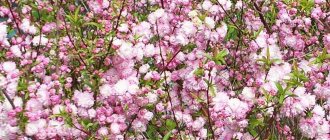Doren is an ornamental shrub, widely used not only for landscaping city parks and squares, but also in gardening. The unique foliage colors of the perennial crop will enliven any landscape design. Due to the unusual color of the trunk, this unpretentious plant does not lose its decorative effect even in winter. Thin reddish branches of turf stick out from the snow-white snowdrifts, reminiscent of summer. And with the arrival of spring, the bush is again covered with beautiful foliage of a multi-colored palette.
Derain shrub
A distinctive feature of this plant is its leaves. Depending on the type and variety, they have different shapes and multi-colored colors. Derain is a frost-resistant and unpretentious shrub to grow, so it is easy to grow without special knowledge.
Derain is able to decorate even the most inconspicuous garden plot
What does derain look like, what family does it belong to?
The deren shrub belongs to the dogwood family and in its natural environment can grow up to 3 meters in height. The bush is very spreading, so it occupies a large space in diameter, from 2 to 3 meters.
The turf has erect, elastic and stable branches that are burgundy-brown in color. Some low-growing varieties may have yellowish-green branches. The large leaves are bright green and have a white or yellow border along the edges.
Turf is a shrub that produces small white or light pink flowers. The flowers are collected in small panicle inflorescences, the diameter of which does not exceed 10 centimeters. Flowering lasts about 2 weeks in May or June. Then small round dark blue berries appear.
How to use turf soil?
What to do with turf soil before use?
Before use, the turf soil must be passed through a fine-mesh mesh, creating something like a screen familiar to all gardeners and gardeners. In this case, all large fractions, as well as those parts that have not decomposed, will roll down the screen, and the smallest parts will pass through it, forming a uniform free-flowing mixture.
After this, the turf soil can be folded into wooden boxes or plastic bags (like sugar bags) and placed in a place inaccessible to sunlight. It is better to keep the bags lying on their sides so that the mixture does not compress.
On the site, that is, literally “in the open air,” ready-to-use turf soil should not be left. Under the influence of rain, sun and wind, as well as changes in day and night temperatures, the turf soil will lose some of its nutritional properties, become less porous, less elastic and naturally less suitable for further use as a component in the preparation of nutritious soil.
Preparation of the resulting turf land immediately before use
Usually, turf soil is not used in its pure form. True, if you have the opportunity to do a chemical analysis of the soil in the laboratory, and the data shows that the main components in the soil you brought are present in sufficient quantities, then, in principle, such soil can be used without additional enrichment.
As a rule, various kinds of “impurities” are added to the turf soil - often these are complex fertilizers, say, nitroammofoska, 10-15 g is enough for a bucket of turf soil. You can add wood ash, it contains up to 5% potassium, you need 500 grams per bucket of turf soil.
Application should be accompanied by thorough mixing until the composition is homogeneous. Sometimes, to increase the amount of turf soil and loosen it somewhat, river sand is added in the amount of one part sand to three parts turf soil.
Next, we strongly recommend disinfecting the turf soil, because essentially anything can be in it, and the fact that it has lain in layers in the cold for one or two winters does not fully guarantee the destruction of pest ovipositors or disease spores.
By the way, the procedure for disinfecting turf soil must be carried out initially, before mixing it with fertilizers or river sand. The best option is to pour boiling water over it. To do this, you need the largest colander, into which you should pour turf soil and pour boiling water from a kettle. Of course, in this way you can destroy beneficial microflora, but in this case the risk is justified and necessary.
Before use, the turf soil must be passed through a fine-mesh mesh. © Superdom
Types of turf
Rough and white deutzia - decorative shrub
The decorative derain shrub has about 30 species and varieties, which differ significantly in the size and color of the leaves. Despite the differences in the plant, all species are popularly called “turf - red bush”. The fact is that almost all varieties of variegated ornamental bushes have stems of rich red color.
The appearance of the shrub may vary
White derain of Sibirica (Cornus Alba Sibirica)
The main difference of the bush is its unusual appearance in winter: the bush has bright red stems. Against the backdrop of snow in bright sunshine, the bush creates an unusual effect. However, the shrub is still valued for its beautiful appearance in the summer garden. The soft green leaves have a washed out white edge.
White dogwood Elegantissima
Elegantissima is famous for its variegated foliage in rich green and white. The foliage is very dense, so the bright red shoots behind it are not very clearly visible.
Additional Information. Because of its color, from a distance Elegantissima appears to be completely covered in small cream flowers.
Variegated white turf Sibirica Variegata
The description of the white turf of Sibirika Variegata is similar to the species of Elegantissima. The bush has green foliage and soft cream colors. With the arrival of autumn, the bright, variegated foliage takes on dark red, lilac and orange hues. The branches have a bright red tint. Planting and caring for the variegated white turf shrub must be done correctly, otherwise the plant may lose its beautiful colors.
White dogwood Spaethii (Cornus alba Spaethii)
In the first years after planting, the plant is actively growing, growing to a maximum of 1.5 meters in height. Unbranched shoots of Shpeta have an erect appearance. The bush has red stems with a barely noticeable yellow border around the edges, which changes to pink in the fall.
Decorative properties of turf in landscape design
This type of turf is in great demand in landscape design. From its crown you can form various shapes and figures. Often designers create compositions from turf and other decorative deciduous shrubs. The shrub looks harmonious with juniper, barberry and pink and white flowers.
Note! Derain is often used as a hedge for zoning areas.
Reasons to use turf in landscape design
The plant is quite in demand in landscape design. Its crown allows you to form various shapes and forms, and the contrasting color of the bark looks interesting against the background of fallen leaves and fallen snow. In addition, the perennial bush combines harmoniously with other foliage plants, which allows designers to create unusual compositions.
It looks very impressive, which is why the plant is often used in landscape design.
The turf shrub transforms the site not only in the warm season, but also in the cold season. In spring, the plant enlivens the garden landscape with budding leaves and blossoms, in summer with beautiful and dense foliage, and in autumn and winter it flaunts bright shoots.
The shrub is attractive both in summer and winter, and besides this, it is unpretentious and resistant to the most difficult climatic conditions.
In the design of local areas, turf is used in different ways. If the plot or garden is visible from all sides, then a high, dense hedge will provide good protection from gusts of wind and prying eyes. A distinctive feature of the shrub is its rapid growth and good branching. Therefore, a hedge is formed in a short time through frequent haircuts.
Variegated dogwood is one of the most striking achievements of breeders; this plant does not grow in the natural environment.
Decorative varieties are used to decorate the garden. Almost all types of plants are unpretentious. Doren tolerates moist soil well, so it is often planted near ponds and reservoirs.
The crop is also used to decorate the undergrowth, since its variegated forms highlight tall plantings well. In this case, a group planting scheme is used. Flowering species are relevant in tapeworm plantings.
The species was obtained on the basis of the white dogwood from the dogwood order.
For garden design, a chic ornamental shrub is a real find. It is popular not only in the design of garden and park areas. Doren tolerates urban conditions well, which is why roadsides are often decorated with it. You can appreciate the beauty of the design of the tree shrubs from the photo.
For reference! The dense growth and roots of the plant perfectly strengthen the soil, protecting the soil from erosion.
Briefly about the history of appearance
Weigela shrub - an ornamental flowering plant for the garden
The homeland of turf is the northern territories of the globe with a temperate climate. The shrub is especially common in Canada and the northern territories of the United States. Some species grow only in Japan and China. A lot of varieties are found exclusively in Russia.
Derain is in great demand among gardeners
Reproduction
White turf is propagated using standard methods:
- growing from seeds;
- cuttings;
- layering.
Read about other shrubs for the garden:
Mahonia holly - a close relative of barberry
Privet is the best shrub for hedges and garden figures
Kochia - fluffy balls of summer cypress
Features of turf care in the garden
Derain does not require special attention to care. Even a novice amateur gardener can cope with planting and caring for white derain shrubs.
Temperature
Forsythia shrub or yellow forthecia - description
The shrub grows well at temperatures of about 20 °C, so it is suitable for growing even in northern latitudes. It will easily tolerate high temperatures if you water the bush in time. Derain is a frost-resistant plant that can withstand cold winds and a small layer of fallen snow.
Lighting
The plant is not picky about lighting. For abundant flowering, it is better to choose non-shaded areas with moderate lighting.
Watering
Young bushes need to be watered every 3-4 days. Mature bushes are unpretentious in the amount of watering and require moisture only in heat and drought, or when the top layer of soil dries out. In autumn, watering is usually suspended.
Spraying
Spraying is carried out rarely and only to add more humidity to the air. Spraying also helps get rid of accumulated dirt and dust on the leaf plates.
Humidity
Derain is not picky about air humidity levels. But severe drought can affect the appearance of the bush - its leaves will begin to turn yellow at the edges. It is best to occasionally spray the bush with water in hot weather.
Priming
Derain can grow on any type of soil, but it is better to choose areas with sandy loam soil. The growing area should be well lit by the sun. The turf does not particularly suffer from a lack or excess of acidity in the soil.
Feeding
Derain is fed twice a season. The first time feeding is carried out in the spring, before flowering. Add complex mineral preparations to decorative foliage plants.
Important ! Nitrogen can be applied only during the first feeding and only before flowering.
The second feeding is carried out at the end of August or at the beginning of September. During this period, organic fertilizers are added in the form of chicken droppings, humus or rotted leaves.
Description of the plant
The Latin name for white turf is Cornus alba, where alba means "white" and Cornus is a genus of Dogwood. The plant received the second part of its name due to its white flowers and unusual spherical fruits. This is one of the most popular representatives of the dogwood family in our country.
The plant has several names: white svidina, dremka, white dogwood, white svidina, povoinik.
The deren shrub is a not too large ornamental deciduous plant 2-3 meters high. The bushes are quite spreading due to large branches that grow widely and take up a lot of space in the garden, so the plant is not suitable for a balcony.
Morphological features:
- The shoots are of an unusual color – red, which gives the bushes a decorative appearance all year round.
- The leaves are round in shape, elliptical at the base, opposite. Foliage densely covers the shoots. Usually the upper part of the leaf blade is yellow or yellow-green, the lower part then turns blue. In autumn, the leaves turn carmine in color and then fall off, exposing the burgundy branches.
- Flowers white wood are not particularly attractive - small, collected in small decorative panicles. Dera flowering period: May-June. The shrub may bloom again in the fall.
- Fruit - small white balls - drupes growing on reddish stems. The fruits are inedible, although birds readily eat them.
Cornus alba is not the only representative of turf growing in our climatic conditions. White dogwood is very decorative, so it is often planted, but the common dogwood is much more common. These are unique ornamental bushes, the fruits of which are a source of valuable ingredients. Edible dogwood fruits have a sour taste, so they are not eaten raw; they are used to make jam and liqueurs. Dogwood fruits are also used to make useful tinctures that improve blood pressure and are used against anemia.
This is a fairly frost-resistant shrub, so turf can be grown in the Urals, Siberia and other cold regions.
Trimming and shaping turf
The bush does not have to be pruned, but most gardeners prefer to use this procedure to form the necessary crown. This is a rather painstaking and time-consuming process. Pruning should be done in the spring or at the very end of summer. Be sure to remove dried branches, then cut off unnecessary shoots.
It is advisable to trim the decorative bush to form a crown
Growing and care
White dogwood is easy to care for, but this does not mean that it can be left completely unattended. Regular watering, weeding and pruning with fertilizing - this is the set of measures that will ensure a long life for the shrub.
Watering
Young plants are watered regularly after planting, about once every ten days, adding a bucket of water . Adult plants need additional moisture depending on the weather. If the summer is wet, additional watering can be canceled.
The soil is moistened only in the morning or evening hours, otherwise the moisture will evaporate too quickly without reaching the roots.
Fertilizer
Doren needs mineral support no less than other ornamental crops , but only if it grows on poor soils.
In spring, the vigor of the shrub is maintained with the help of nitrogen fertilizers, which are applied along with watering.
In summer, the best fertilizer will be fresh, ready-made compost or peat.
Trimming
Formative pruning is carried out as the bush loses its given shape . In addition to formative pruning, the dogwood requires regular sanitary cleaning.
Their goal is to remove old, dry and damaged branches. Sanitary pruning stimulates the formation of new young shoots and gives the plant the necessary volume.
Wintering
Svida white tolerates frosty winters well . It is recommended to equip young plants with additional shelter for the winter, but adult bushes winter without it.
If the branches are frozen in winter, they can be removed in the spring without much damage to the decorative appearance of the bush.
How does turf propagate?
The plant is propagated at home by cuttings; less often, seeds can be germinated.
Germination of seeds
Propagation of derain by seeds is a rather difficult and long process. First, you need to germinate the seeds at home in a small box as seedlings. After planting in the ground, wait about 7 years until the turf grows to its normal size.
Important! Despite the labor-intensive process, turf seeds have 100% germination rate.
Rooting cuttings
In the spring, cuttings with 8 buds on it are cut from the main bush. The cuttings are planted in a turf substrate. The cuttings must be regularly watered and fertilized. As soon as the cuttings take root, they are planted in open ground. Cuttings must be looked after.
Advantages of turf soil as part of a garden mixture
How are garden mixtures different?
First, let's talk about the obvious differences between garden mixtures, because their composition is sometimes very different. Considering the main ingredient of the garden mixture, you can understand whether the mixture is sour or not. For example, if the garden mixture contains peat and there are no deoxidizing agents such as dolomite flour, then there is a high probability that the soil will be acidic.
And if turf soil is present as a base, this may indicate that the soil has a neutral reaction (but this is not 100%, so it is still advisable to check the acidity of the soil by analysis).
What is good about turf soil?
It is especially loved by gardeners because it contains an abundance of nutrients, is rich in minerals, is considered light soil and moisture-permeable, although the values of the latter properties are rather average.
Quite often, turf soil is the basis of many soil mixtures, and such mixtures are readily purchased by people who do not accept the acid and “uselessness” of peat.
The amount of turf soil in the soil mixture
Typically, the amount of turf soil in the soil mixture can vary greatly and range from a third to a half of the entire mixture. However, we should not forget that the turf mixture, despite its nutritional value, may be quite low in nitrogen; as a result, additional additions of this element will be required.
If we talk about the acidity of turf soil on average, then turf soil is usually (but not always) close in this indicator to compost soil, because turf soil is often formed from the same “substances” as compost, only over a longer period of time.
Replanting turf
Replanting turf when it is growing healthy and properly maintained is not necessary and is purely a matter of personal preference and necessity. It is recommended to replant the bush in the spring, before the buds begin to swell. The bush is dug up along with the soil at the roots and transplanted into a hole previously dug for replanting. It is better to add humus or rotted leaves into the hole before planting. After planting, the turf is watered generously with slightly cool rainwater.
Important! The bush is dug out carefully so as not to damage the root system.
Landing
The best time to plant turf is autumn or spring.
Requirements for soil and planting site
White derain does not make any special demands on its position in the garden and is highly resistant to unfavorable growing conditions.
The shrub can grow in almost any garden plot, but especially loves soils:
- fertile,
- humus,
- slightly damp,
- with an acidic or neutral reaction.
Derain will withstand even heavy, wetlands and copes well with dry, sandy soil.
The plant grows successfully in a sunny position. Varieties with multi-colored leaves show much better color in areas exposed to intense sun. This unique plant tolerates almost any type of soil and tolerates air pollution in cities. Therefore, shrubs can be found in rural gardens, city parks, squares, and dachas, especially since caring for them is easy.
Planting - step by step
- When planting white sod, first get rid of weeds in the area, which take moisture and nutrients from the soil. You can use agrofibre, which will reduce the number of weeds in the future. It is also necessary to clean the soil from contaminants - construction waste, garbage.
- You can improve the soil structure by enriching it with organic matter. If the soil is impermeable, in loam, you can add sand and a little garden peat.
- Dig a hole with a diameter of 30 cm and a depth of 50 cm. The depth should be deep enough so that the roots are completely covered. The hole should be 1.5 times the diameter of the root ball and 1.5 times deeper than the height of the root ball. Then it will be easy to plant the plant.
- It is recommended to loosen the soil at the bottom of the hole and on the walls with a pitchfork or shovel. This will encourage rapid root growth in the soil.
- Before planting the bush in the hole, it is worth soaking it. Plants are immersed in water for 10-30 minutes. When removing a seedling from a pot, we try not to injure the root ball, only weaken it by hand. If, after removing the lump from the container, it is clear that the roots are very compacted and twisted, it is recommended to loosen them a little with a knife or trim them with scissors. This treatment will allow the roots to be better accepted into the ground.
Attention! The root collar (the dark mark on the plant's trunk where it came into contact with the soil in the pot) should not be covered with soil. You need to plant the turf at the same depth at which it grew in the pot.
- Fill the hole with garden soil mixed with peat.
- After planting the tree, you should immediately shorten the shoots so that the new growth compacts the crown well. Dry or damaged shoots should be trimmed.
- When filling in the roots, it is worth forming a depression (hole) around the bush, from which water will not flow out when watering.
- Watering is carried out immediately after planting, water abundantly.
It is recommended to fertilize the plant when planting or 4-6 weeks after planting. If the seedlings are planted in the fall, they are fertilized only in the spring.
It is recommended to mulch the soil around the bush to protect the root system from drying out, avoid excessive weed growth and soil freezing. Apply:
- It is better to mulch the turf with crushed pine bark, which will ensure a favorable soil pH. The bark is scattered in a layer 5 cm thick.
- You can mulch with compost, but at a distance of 5 cm from the base of the bush.
- A layer of decorative stones about 3 cm high.
Possible problems in growing turf
The bush may develop a fungus. The leaves will begin to turn brown and black, then fall off. Sometimes local brown spots may appear on the stems of the bush. If you don't pay attention to them, the branch will completely dry out and die. This problem occurs due to excessive watering or watering with cold water. Watering water should be slightly cool and not hard. The fungus can be cured by treating the turf with a solution of Bordeaux mixture or special preparations, such as Vectra or Fundazol.
High humidity and excessive shading of the area provoke the appearance of powdery mildew. It looks like a powdery coating on the leaf blades. Soon the leaves turn yellow, curl and eventually fall off. They get rid of it with special drugs.
If the leaves suddenly dry out and turn yellow right up to the central vein, then the bush has received sunburn. A transplant to a more favorable and shaded place is necessary.
Note! Derain has a specific smell that repels pests.
With its unusual variegated leaf colors, derain has gained immense popularity in landscape design. Simple care, along with a beautiful appearance, is attracting more and more attention to the turf around the world.
Application of turf soil
Turf soil is usually used for growing a wide variety of indoor plants and seedlings, for forcing green crops or growing vegetable crops in winter for the sake of obtaining an “out of season” harvest.
The main thing is to use the turf soil correctly, loosen the top layer more often, water it, apply fertilizers if this or that plant needs it, and when placing it in a container, be sure to initially lay a drainage layer there, the role of which can be played by expanded clay, broken brick, pebbles or other small pebbles.
Diseases and pests
White Siberian dogwood is resistant to diseases and insects. However, the bush still needs preventive measures. Untreated plants can be affected by aphids and scale insects. It is worth noting that with regular application of mineral root and foliar fertilizers, the risk of damage by these pests is reduced to zero.
Advice! If a plant is damaged by insects, summer residents recommend treating the plants with Karbofos.
For home remedies, you can use an onion composition, a decoction of potato tops, or a herbal infusion of yarrow.
If a plant is affected by powdery mildew, it is necessary to treat it with colloidal sulfur or a soda composition with the addition of laundry soap. Bordeaux mixture will help get rid of stains on leaves. To combat gray rot, bushes are treated with Vectra.
Shrubs that do not require cutting
Snowberry
A honeysuckle shrub with bluish-green leaves that contrast with the large pinkish flowers. The crop does not grow more than 130 centimeters and is not suitable for decorating the area with figured plantings, since the shoots are difficult to tolerate cutting. But it is recommended to remove faded flowers for further formation of buds.
Dogwood
A feature of the shrub is the seasonal change in leaf color. In spring and summer, the foliage is green, and starting in autumn, the color changes to yellow, and later to deep purple. The shrub will grow quietly in the shade, in any type of soil, but for abundant growth it is recommended to fertilize the soil when planting. To plant a hedge, you should not take an adult plant (up to 3 years old). The plant grows up to 30 centimeters per year.
Clematis (Clematis)
See description above.
Boxwood
This small and compact shrub attracts designers and gardeners with its unusual leaf shape, reminiscent of four-leaf clovers, and its ease of care. The plant will not require special choice of location or soil, but will prefer infrequent watering during dry periods. As the shrub grows, it creates a dense, but not high hedge (in the first 5 years it adds 10-20 centimeters in height), which independently acquires the correct geometric shape, requiring almost no pruning or trimming.
Faulkner Boxwood, Buxus 'Faulkner', at Visalia CA USA Faulkner Boxwood, Buxus 'Faulkner', at Visalia CA USA
Kalmiya
This shrub will be loved by many for its lack of need for cutting and caring for shoots. It is recommended to plant the crop in partial shade, without direct sunlight and without stagnant water in the soil. The plant blooms profusely - the color and timing of flowering directly depends on the variety and care. It is important to plant young seedlings at a sufficient distance from each other (50-60 centimeters), since the shoots grow quickly and interfere with the normal growth of neighboring bushes.
